I did not see this coming. Continue reading →
The Vatican recently announced that Pope Francis would canonize two popes, John XXIII and John Paul II. This is truly astounding news. Only three popes since the eleventh century have been canonized. Each of those should probably include an asterisk.
-
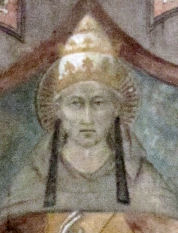
Detail of a fresco in Castel Nuovo in Naples.
Celestine V (1294) should never have been pope. He was a reclusive and ascetic hermit, who had had little contact with humankind for decades. He never even made it to Rome; he took up residence in King Charles’s castle in Naples. After five months of incompetent bungling he was persuaded to resign by his successor, Boniface VIII. The latter promptly imprisoned Celestine, who died in his cell. The King of France, Philip the Fair, hated Pope Boniface, and, after the pontiff died, the king worked hard both to have Celestine canonized and Boniface condemned. He succeeded in the first, but not the second.
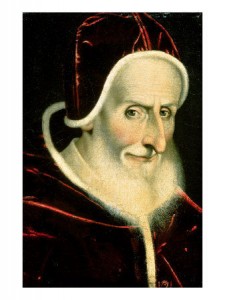 Pius V (1566-1572) was a Grand Inquisitor before he was elected pontiff. He set up a network of spies and informants who fingered people who blasphemed or expressed opinions that could be considered heretical. He also tirelessly strove to rid the world of all forms of evil, and that included Protestants. He conspired with Catherine de’ Medici to exterminate the Huguenots in France. Their plot culminated in the St. Bartholomew’s Day massacre, which occurred a short time after the pope’s death in 1572.
Pius V (1566-1572) was a Grand Inquisitor before he was elected pontiff. He set up a network of spies and informants who fingered people who blasphemed or expressed opinions that could be considered heretical. He also tirelessly strove to rid the world of all forms of evil, and that included Protestants. He conspired with Catherine de’ Medici to exterminate the Huguenots in France. Their plot culminated in the St. Bartholomew’s Day massacre, which occurred a short time after the pope’s death in 1572.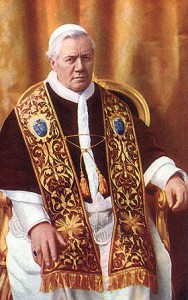 Pius X (1903-1904) campaigned against “modernism,” which in his mind included nearly everything that St. Thomas Aquinas had not thought of by the time that he died in 1274. He banned much beautiful music (Mozart, Beethoven, Vivaldi, et al.) from the liturgy. I have long thought that he must have been tone-deaf. He continued the fiction perpetrated by his two predecessors that he was a prisoner in Vatican City. He did not take sides in the runup to World War I, but he definitely admired Kaiser Wilhelm.
Pius X (1903-1904) campaigned against “modernism,” which in his mind included nearly everything that St. Thomas Aquinas had not thought of by the time that he died in 1274. He banned much beautiful music (Mozart, Beethoven, Vivaldi, et al.) from the liturgy. I have long thought that he must have been tone-deaf. He continued the fiction perpetrated by his two predecessors that he was a prisoner in Vatican City. He did not take sides in the runup to World War I, but he definitely admired Kaiser Wilhelm.
All three of these men were saintly, in that they prayed both fervently and continually throughout their lives. I, for one, am happy, however, that very few of their prayers were answered.
When Pope Benedict XVI paid scant attention to the cries of “santo subito” that rang out during the burial ceremonies for his predecessor, John Paul II, I assumed that canonization would not be coming for decades, if then. Many popes have been beatified, but naming one as a saint has been considered by Vatican-watchers as a politically risky move. I never thought that John XXIII (1958-1963) had a chance.
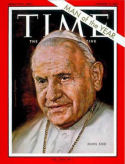 Both of these pontificates were somewhat controversial. Pope John called the Second Vatican Council, which, in the minds of millions of conservative Catholics, started the Church on a long downward slide. A strong feeling persists among a very large segment of the clergy that he lowered standards to the point that the Church lost its way. They played guitars during mass! Also, he told jokes.
Both of these pontificates were somewhat controversial. Pope John called the Second Vatican Council, which, in the minds of millions of conservative Catholics, started the Church on a long downward slide. A strong feeling persists among a very large segment of the clergy that he lowered standards to the point that the Church lost its way. They played guitars during mass! Also, he told jokes.
 The highlights of John Paul’s pontificate included his many celebrated trips around the world. The first visit to Poland helped to coalesce the Polish people around the idea of Christianity as a counter to Communism. There is no question that the pope contributed a great deal to the struggle that eventually resulted in the fall of the Iron Curtain. The millions of dollars that the Church directed to the Polish Labor Union Solidarity enabled it to become a political force strong enough to oust the puppet regime and begin the process of freeing the central European countries from the clutches of Russia.
The highlights of John Paul’s pontificate included his many celebrated trips around the world. The first visit to Poland helped to coalesce the Polish people around the idea of Christianity as a counter to Communism. There is no question that the pope contributed a great deal to the struggle that eventually resulted in the fall of the Iron Curtain. The millions of dollars that the Church directed to the Polish Labor Union Solidarity enabled it to become a political force strong enough to oust the puppet regime and begin the process of freeing the central European countries from the clutches of Russia.
Pundits have speculated that John Paul’s seeming disinterest in the many clerical sex abuse cases would weigh heavily against the prospects of his canonization. Among the clerical hierarchy this might not be that important. Most of them would have done the same thing if they were in his brogans.
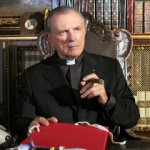
Bishop Paulius Marcinkus.
On the other hand, there is the little matter of the Vatican Bank scandal that spanned the last years of Paul VI’s pontificate and the early years of John Paul’s. If there were still a Devil’s Advocate process, I wonder how the person defending the pope’s reputation would answer the charges that the bank lost hundreds of millions of dollars while engaging in schemes that involved some of the shadiest characters around, at least two of whom ended up murdered. The director of the bank, an American named Paulius Marcinkus, was indicted by the Italian government, but he was never arrested because he avoided Italian soil by staying in Vatican City. Pope John Paul definitely protected Bishop Marcincus, who had twice saved the pontiff’s life by subduing armed assailants.
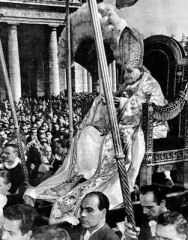 One good thing that may come from this unusual event is to diminish the emphasis on so-called miracles. These two men did not walk on water; in fact Pope John hardly ever walked on land because in his time the pontiff was still carried around in the outrageous sedia gestatoria! The miracles mentioned these days almost always are based upon testimony that someone was cured of a fatal disease or injury because someone prayed to the new saint or used an object related to him to effect a cure.
One good thing that may come from this unusual event is to diminish the emphasis on so-called miracles. These two men did not walk on water; in fact Pope John hardly ever walked on land because in his time the pontiff was still carried around in the outrageous sedia gestatoria! The miracles mentioned these days almost always are based upon testimony that someone was cured of a fatal disease or injury because someone prayed to the new saint or used an object related to him to effect a cure.
I assumed from what I had read that the conservatives in the Curia were too powerful for any pontiff to consider nominating John Paul II, much less John XXIII, for canonization. In theory the pope can do whatever he wants, but every pope in the last few centuries has been careful about stepping on the toes of those of high rank. Maybe their power was just overrated; maybe Pope Francis just doesn’t care. It will be interesting to see if any backstabbing results from this.
I know one thing: conservative American Catholics cannot be happy. John XXIII was an unrepentant liberal, and John Paul II, although conservative when it came to doctrinal matters, had absolutely no use for George W. Bush and his wars. He personally persuaded several leaders to vote against the UN resolutions concerning the invasion of Iraq.








